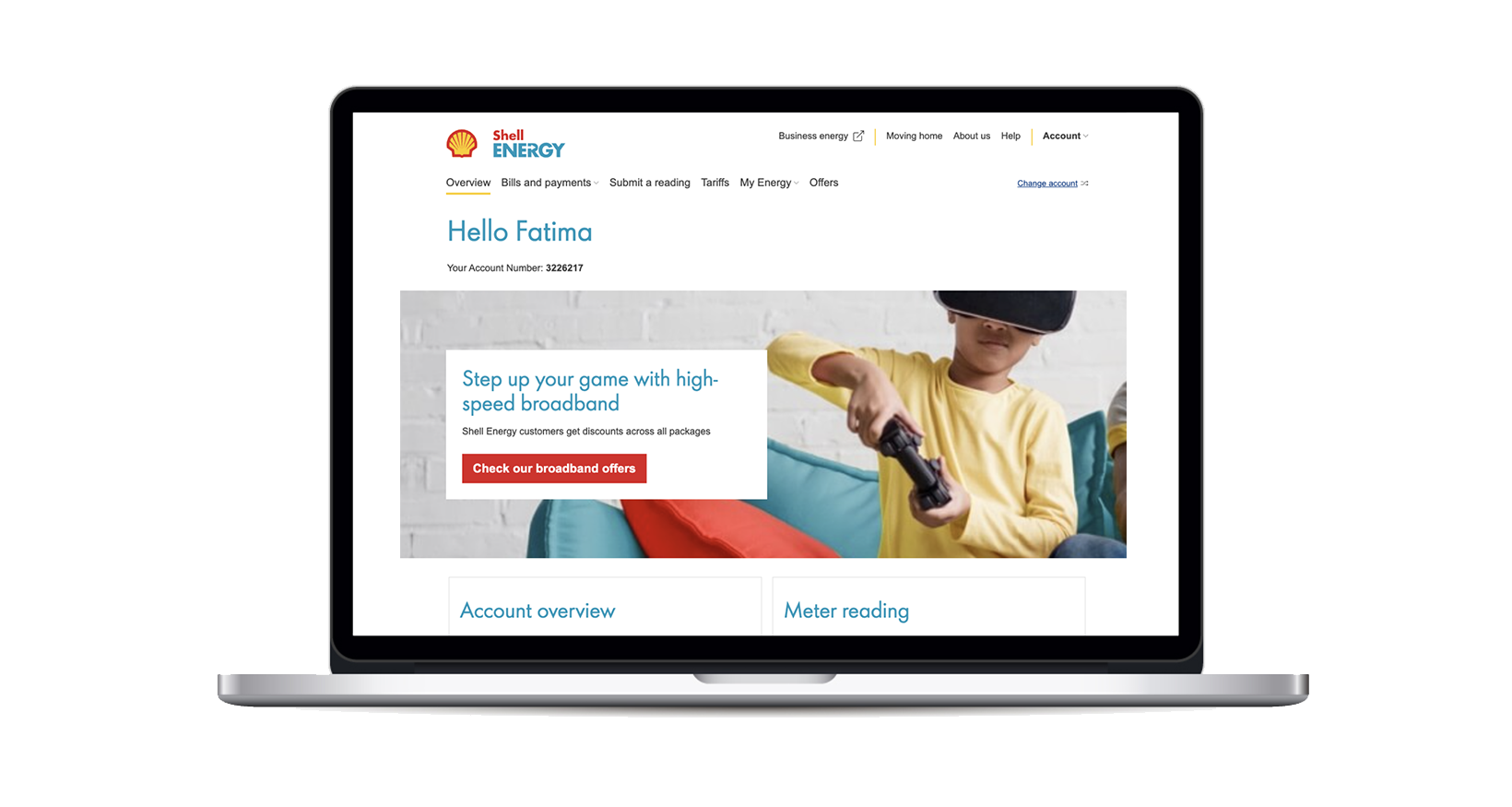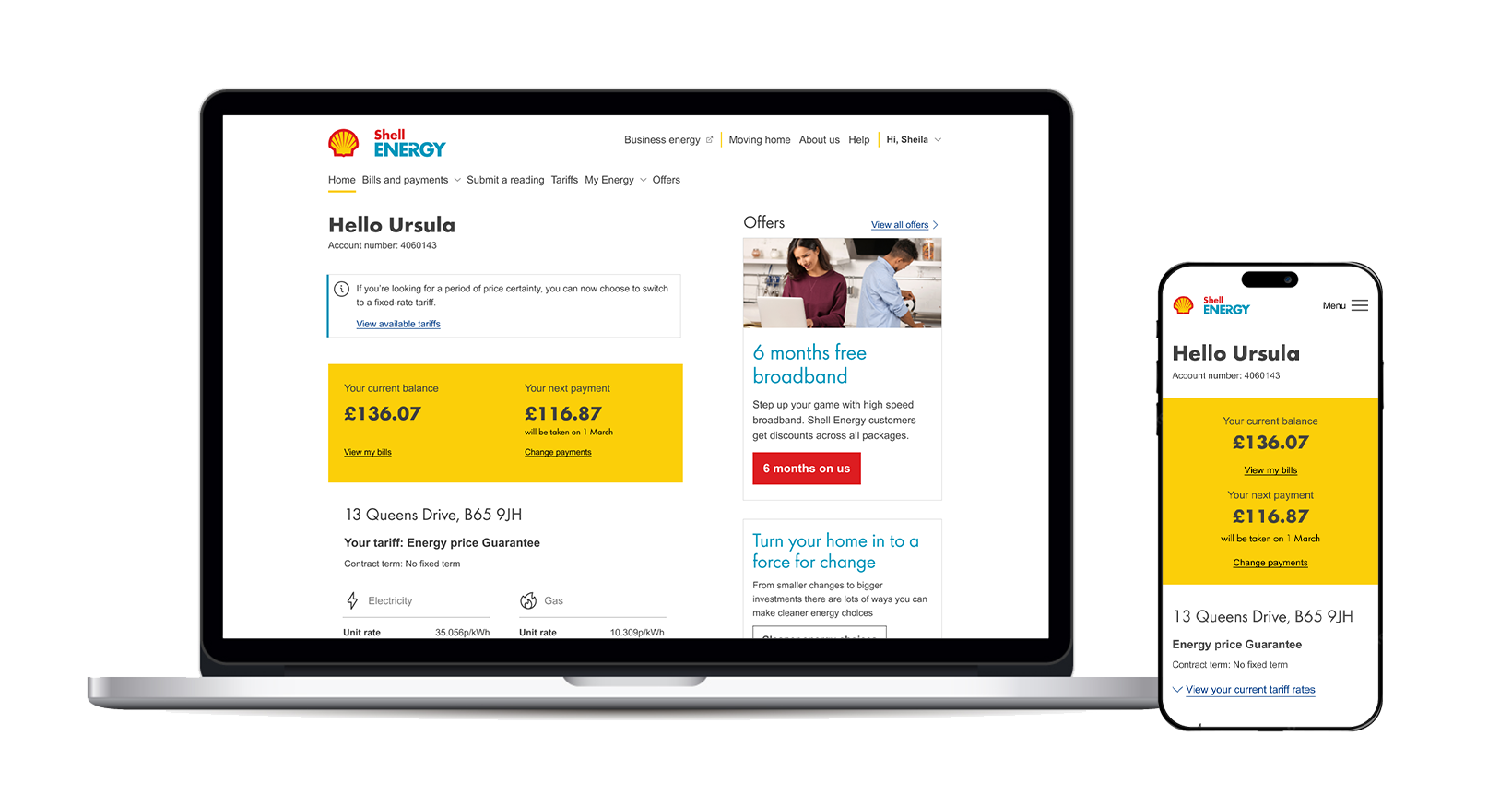The journey to a new account experience for Shell Energy customers.
To provide a more engaging, customer focused account dashboard that allowed us to support our customers better. Signposting great offers and helpful advice for saving energy and money, personalised to the customer profile.
Outcome: Create a personalised user experience that helped the customer manage their energy better and find other ways to save energy and money through smart offers and advice.
A much neglected account landing page offered little more than a barrier to customer wanting to complete basic account management tasks, which due to technical limitations, had been pushed back in the account. Surfacing the most important information and using smart notifications would provide an improved, personalised experience to help customers manage their account and better understand their usage especially in such a volatile environment.


1. Starting with the data
Current behaviours
Diving in to the analytics I quickly identified the patterns and behaviours that showed how users currently navigated the account. This data allowed me to quickly learn what worked well, which functionality were most used and areas where I could improve the customer experience by reducing clicks and the time spent completing key actions.
Customer feedback
Online feedback tools also provided key insight in to the issues our customers were encountering with the current navigation and structure. Frustrated comments highlighting how they couldn’t see how to complete actions that were available, but clearly not easy to find.
Business objectives
Providing better self-serve capabilities would not only improve the experience for the customer but also reduce contacts, improving efficiency for our contact centre colleagues. Putting their skills to better use with calls that needed their knowledge and experience. However, I also wanted to go the extra mile to help our customers get the most from all the products, services, help and advice we could offer. Opportunity for cross sell was previously very limited, with awareness of multi-product discounts very low.
Competitor analysis
Thanks to the support of colleagues from around the business I was able to gather access to a wide range of energy accounts from our competitors. In addition to these, it was important to look beyond the energy and telco industries and find the best in class experiences from other brands. Taking ideas and inspiration from these external influences was going to be valuable in ensuring I could design a solution that would utilise familiar patterns, making the overall experience more intuitive and easier to use.
Internal knowledge and experience
Bringing together representation from all areas of the business to build on our understanding of the current issues customers faced, the challenges that caused customers to call the contact centre. Working with commercial, marketing and brand to ensure I could deliver on business objectives and provide the right opportunities to talk to our customers about other products, services and offers that would help them get more from us.
2. Building a vision
Mapping out a long term vision
With all the data I had gathered at this stage, I began to build a broad direction of where we should be taking the user account to best meet the needs of our customers. While the project was initially focused on the account overview it was imperative to consider all areas of the account as these could be impacted by any changes we made. An account that had evolved over time, fresh thinking and a review of the overall hierarchy was something that needed to be considered.
Defining the steps to achieve it
With a long term vision in place we could start to break this down in to smaller deliverables that would allow us to deliver value more quickly to a customer and learn as we go. Always working towards our broader vision but with the flexibility to realign our thinking, and reprioritise our backlog based on the data we would see once the first changes went in front of customers.
3. Design and prototyping
Design
With the vision and user stories in place I could start to work up the designs for the detailed, high fidelity designs for the first few stories. Having a number of stories worked up and ready allowed for flexibility in the priority following technical discovery, and ensured that the development team would have sight of the upcoming changes and we could keep a steady pace of delivery.
Prototyping
Functional prototypes were an essential aspect of the testing phase. Allowing users to experience the designs I'd created in a way that closely reflected the end experience was important in ensuring we got the most from our test participants. Quality prototypes are also a more cost effective way of gaining confidence we are building the right thing, and making quick changes ahead of development.
4. Testing and re-testing
User testing
Our first round of testing consisted of a series of moderated tests, asking participants to complete a number of steps to complete some of the more common tasks I'd seen in the account to date. These were followed by more general conversations about what else would could be looking to include to make managing their account easier and more enjoyable.
Unmoderated user testing
Following analysis of the initial test data we made some adjustments to the design and were keen to validate these changes, so conducted additional testing. These tests were unmoderated, with users being asked to complete a few common tasks in two different designs. Followed by a questionnaire to understand which design was their preferred and why. These proved to be super efficient way of reaching a larger audience more quickly to iron out any initial concerns raised in the first round.
Measuring success
Analytics
It was crucial to ensure that all the necessary reporting and analytics tools were in place to capture valuable data about how users were interacting with the new account experience. This data would be used to continue to evolve the experience and prioritise our future enhancements.
Customer feedback
In addition to the analytics we utilised online feedback tool Get Feedback to track comments and mood rating from customers using the platform. Prior to the changes this had recorded an average Mood rating of 2.1 out of 5, following the changes this was now averaging 3.9, and the additional effort score we started to capture also sat at 3.9.